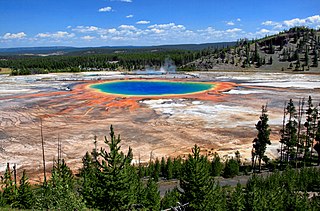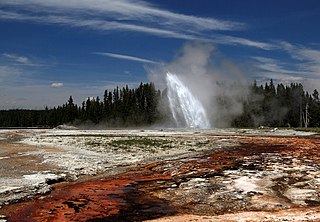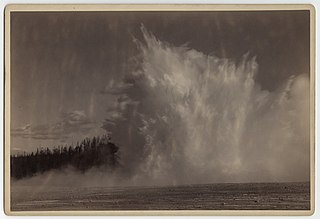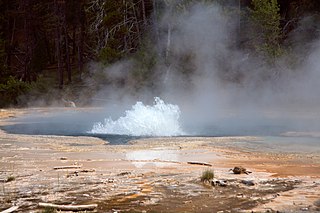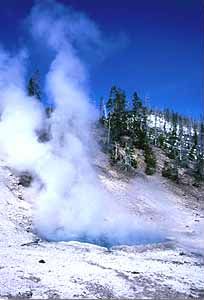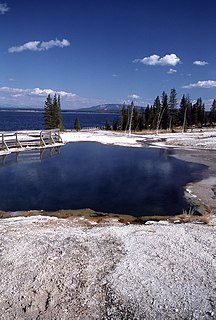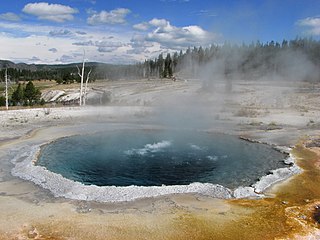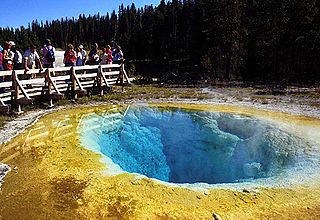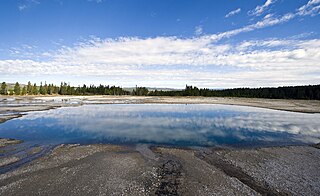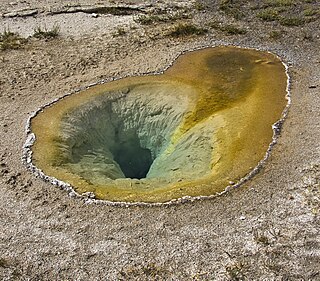| Jewel Geyser | |
|---|---|
 Jewel Geyser | |
| Name origin | named for the beads of pearly sinter around the geyser's vent. |
| Location | Biscuit Basin, Upper Geyser Basin, Yellowstone National Park, Wyoming |
| Coordinates | 44°29′06″N110°51′22″W / 44.4849062°N 110.8561833°W [1] |
| Elevation | 7,798 feet (2,377 m) [2] |
| Type | Fountain geyser |
| Eruption height | up to 20 ft |
| Frequency | 8-9 minutes [ citation needed ] |
| Duration | seconds |
| Temperature | 86.5 °C (187.7 °F) [1] |
Jewel Geyser is a fountain geyser in the Upper Geyser Basin of Yellowstone National Park in the United States. It is in the Biscuit Basin complex that includes Black Diamond Pool, Black Opal Spring, Wall Pool, Sapphire Pool, Shell Spring, Silver Globe Spring, Avoca Spring, West Geyser, the Mustard Springs, Coral Geyser, and Black Pearl Geyser. [3]

A geyser is a spring characterized by intermittent discharge of water ejected turbulently and accompanied by steam. As a fairly rare phenomenon, the formation of geysers is due to particular hydrogeological conditions that exist only in a few places on Earth. Generally all geyser field sites are located near active volcanic areas, and the geyser effect is due to the proximity of magma. Generally, surface water works its way down to an average depth of around 2,000 metres (6,600 ft) where it contacts hot rocks. The resultant boiling of the pressurized water results in the geyser effect of hot water and steam spraying out of the geyser's surface vent.

Yellowstone National Park is an American national park located in Wyoming, Montana, and Idaho. It was established by the U.S. Congress and signed into law by President Ulysses S. Grant on March 1, 1872. Yellowstone was the first national park in the U.S. and is also widely held to be the first national park in the world. The park is known for its wildlife and its many geothermal features, especially Old Faithful geyser, one of its most popular features. It has many types of ecosystems, but the subalpine forest is the most abundant. It is part of the South Central Rockies forests ecoregion.
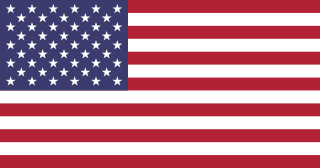
The United States of America (USA), commonly known as the United States or America, is a country composed of 50 states, a federal district, five major self-governing territories, and various possessions. At 3.8 million square miles, the United States is the world's third or fourth largest country by total area and is slightly smaller than the entire continent of Europe's 3.9 million square miles. With a population of over 327 million people, the U.S. is the third most populous country. The capital is Washington, D.C., and the largest city by population is New York City. Forty-eight states and the capital's federal district are contiguous in North America between Canada and Mexico. The State of Alaska is in the northwest corner of North America, bordered by Canada to the east and across the Bering Strait from Russia to the west. The State of Hawaii is an archipelago in the mid-Pacific Ocean. The U.S. territories are scattered about the Pacific Ocean and the Caribbean Sea, stretching across nine official time zones. The extremely diverse geography, climate, and wildlife of the United States make it one of the world's 17 megadiverse countries.
Originally named Soda Geyser by the Hayden Survey, but it was renamed to Jewel Geyser by Arnold Hague in 1887. [4] Jewel Geyser is known for having a shiny, beaded sinter around its vent and erupting frequently. [5]

Arnold Hague was a United States geologist who did many geological surveys in the U.S., of which the best known was that for Yellowstone National Park. He also had assignments in China and Guatemala. He became a member of the U. S. Geological Survey in 1879 when it was first organized.
